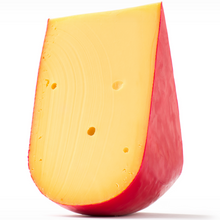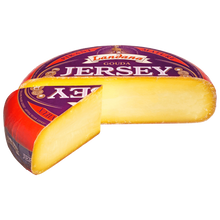Gouda 100g
通常価格
¥770
販売中
ゴーダ
ゴーダチーズは、エダムチーズと並ぶオランダの代表的なチーズ。オランダでのチーズ生産量の60 %を占める。ロッテルダム近郊の町、ゴーダで作られたことからこの名前がついた。正確な起源は不明だが12世紀頃にまで溯るとされることが多い。
外見は黄色がかった茶色い円盤型で、正式なサイズが直径35 cm×高さ11 cm・重さ約12 kgと決められており、それより小さなものを総称して「ベビーゴーダ」と呼んでいる。中は白から黄色。熟成と共に色が変化する。熟成されたゴーダの中には表面が黒いものもある。
クミンシードやニンニクなどを用いて香りをつけたものもある。
主な材料は牛乳とレンネット(凝乳酵素)。
チーズの種類としてはセミハードに分類される。味はマイルドで日本では比較的広く親しまれている。
オランダでは土産物として空港などで売られている他、食料品店、チーズ販売店などでもほぼ置いている。チーズ店などでは特に包装をしていないものを常温で積み上げている場合もある。これは表面をロウでコーティングしてあり、ナイフを入れない限り熟成が急激に進む心配がないため。
Gouda
Gouda is a sweet, creamy, yellow cow's milk cheese originating from the Netherlands. It is one of the most popular cheeses worldwide. The name is used today as a general term for numerous similar cheeses produced in the traditional Dutch manner.
The first mention of Gouda cheese dates from 1284, making it one of the oldest recorded cheeses in the world still made today. Cheesemaking traditionally was a woman's task in Dutch culture, with farmers' wives passing their cheesemaking skills on to their daughters. During summer months in the city of Gouda, South Holland, there is a cheese market in traditional style once a week primarily as a tourist attraction. Most Dutch Gouda is now produced industrially. However, some 300 Dutch farmers still produce boerenkaas which is a protected form of Gouda made in the traditional manner, using unpasteurized milk.
The cheese is named after the master of Gouda, not because it was produced in or around that city, but because it was traded there. In the Middle Ages, Dutch cities could obtain certain feudal rights which gave them primacy or a total monopoly on certain goods. Within the County of Holland, Gouda acquired market rights on cheese, the sole right to have a market in which the county's farmers could sell their cheese. All the cheeses would be taken to the market square in Gouda to be sold. Teams consisting of the guild of cheese-porters, identified by distinct differently colored straw hats, carried the farmers' cheeses, which typically weighed about 16 kg (35 lb), in barrows. Buyers then sampled the cheeses and negotiated a price using a ritual bargaining system called handjeklap in which buyers and sellers clap each other's hands and shout out prices. Once a price was agreed upon, the porters would carry the cheese to the weighing house and complete the sale.








